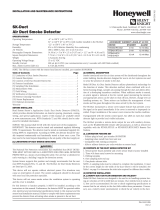
INSTALLATION MANUAL: PAD100-DUCT ANALOG ADDRESSABLE DUCT DETECTOR
Document 5406322-A 05/16
Potter Electric Signal Company, LLC • St. Louis, MO • Phone: (800) 325-3936 • www.pottersignal.com
PAGE 3 OF 4
5. Mechanical Installation Instructions
LOCATION PREREQUISITES: This guideline contains general information on the PAD100-DUCT duct smoke detector installation,
but does not preclude the NFPA and/or ICC documents listed. Potter Electric Signal Company assumes no responsibility for
improperly installed duct detectors. To determine the correct installation position for a PAD100-DUCT duct smoke detector, the
following factors must be considered.
A. A uniform non-turbulent (laminar) airow between 100 ft/min. to 4,000 ft/min. must be present in the HVAC duct. To determine
duct velocities, examine the engineering specications that dene the expected velocities or use an Alnor model 6000AP
velocity meter (or equivalent).
B. To minimize the impact of air turbulence and stratication on performance, a duct smoke detector should be located as far
as possible downstream from any obstruction (i.e. deector plates, elbows, dampers, etc.). In all situations, conrmation of
velocity and pressure differential within specications is required.
The pressure differential between the input sampling high pressure) tube and exhaust (low pressure) tube for the PAD100-
DUCT duct smoke detector should be greater than 0.01 inches of water and less than 1.2 inches of water.
C. Identify a code compliant location (supply or return side, or both) for the installation of the duct unit that will permit easy access
for viewing and serviceability.
D. When installing on the return side, install duct units prior to the air being exhausted from the building or diluted with outside
“fresh” air.
E. When installing duct smoke units downstream of lters, res occurring in the lters will be detected, but if the lters become
blocked, insufcient air ow through the duct unit will prevent the correct operation of the duct detector. Duct units installed in
the supply air side may monitor upstream equipment and/or lters.
F. Where possible, install duct detectors upstream of air humidiers and downstream of dehumidiers.
G. To prevent false alarms, the duct detector should not be mounted in areas of extreme high or low temperatures, in areas
where high humidity exists, or in areas where the duct may contain gases or excessive dust.
SAMPLING TUBE ASSEMBLY: The PAD100-DUCT duct smoke detectors employ a specially notched sampling tube, which may
be ordered separately in one of four (4) standard lengths.
STN-1.0 For duct widths of 6” TO 1.0’
STN-2.5 For duct widths of 1.0’ TO 3.0’
STN-5.0 For duct widths of 3.0’ TO 5.0’
STN-10.0 For duct widths of 5.0’ TO 10.0’
Standard sampling tubes are steel tubes with air intake holes located the entire length of the tube. These tubes must be cut to
length and should span the entire width of the duct. Sampling tubes over 3.0’ must be supported on the opposite side of the duct.
To ensure the correct operation of the sensing tube, the red end cap (red stopper in installation kit) must be inserted in the end
of the air intake sampling tube. For custom duct widths, always use the next longest standard size and cut down to the exact
requirement.
“NO-TOOLS” TUBE INSTALLATION: The PAD100-DUCT duct smoke detector provides a unique, patented mechanism for
installation and/or removal of the sampling and exhaust tubes from either the front or rear of the detector housing. Once the airow
direction has been determined, insert the inlet and exhaust tubes into the duct smoke detector. If the cover is in place, the tubes
may be inserted into the back of the detector via the key-slots provided. Simply push the tube into place against the spring loaded
retainer, and turn into the correct position, allowing the key to “lock” the tube in the desired orientation. For front side installation,
simply rotate the tube retainer until the tube may be inserted and oriented properly. Once the tube is installed, rotate the retainer
back into place to lock down the tube. Ensure air intake sampling tube is positioned so that the inlet holes are directly facing the
airow.
Figure 4. Example of the PAD100-DUCT Duct Detector Placement
INLET TUBE
HOLES FACE
AIR FLOW
DUCT WIDTH AIR FLOW DIRECTION
INSERT RED STOPPER
THIS END OF INLET TUBE
EXHAUST TUBE INSTALLED
DOWNSTREAM OF AIRFLOW
DO NOT INSERT RED STOPPER
NOTE: Mountings shown
are typical. Detectors can
be installed side, bottom
or top of duct as long as
proper tube operation and
flow/pressure performance
is maintained
Tube Support Hole only for Ducts Greater than 3 Feet





